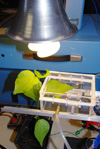
A Memorial for the Still Living. Premiered at John Hansard Gallery in Southampton. Upcoming show at the Horniman Museum in London.
BOOK
Tactical Biopolitics: Art, Activism, and Technoscience. MIT Press; Leonardo Book Series. ed., Beatriz da Costa & Kavita Philip.
WORKSHOP
Invisible Earthlings Workshop. [as part of "Species We Live With"]

Pigeonblog [documentation & ephemera] on view at Sweeney Art Gallery in Riverside, CA.

REVIEWS/INTERVIEWS I LIKE
The Place of Art in the Age of Biotechnological Reproducibility. (pdf) [Review of Tactical Biopolitics in "BioSocieties."]
Processes, Issues AIR: Toward Reticular Politics. (pdf) [Full fledged article about Preemptive Media's and my work in "Australian Humanities Review."]
Interview with Beatriz da Costa. (pdf) [by Alessandro Ludovico, "Neural Magazine."]

COLLABORATIVE
Preemptive Media Preemptive Media is a collaborative operating at the nexus of art, activism and technology.

BEATRIZ DA COSTA
Beatriz da Costa is an interdisciplinary artist based in Los Angeles. She works at the intersection of art, politics, engineering and the life sciences.




YEAST sensor and workshop at ISEA in 2006
Experiments in Biosensing took various forms and public manifestations.
It's first version consisted of the construction of an CO sensing yeast colony I created In collaboration with system's biologist Tau-Mu Yi.
The cells were intended to change color (lacZ) in response to high exposure of CO, thereby serving as an experimental air pollution sensor.
While we had some success in laboratory conditions, or sensor wasn't sensitive enough to function in real world condition. We did explain it
construction and function however during a public workshop (as part of Wetwarehackers ) at ISEA 2006.
Participants were able to learn about the different steps involved in modifying yeast cultures for sensing purposes and tested their result in the outdoors.
My original goal however was to develop a plant based pollution sensor using the model plant arabidopsis. Change in color would have been the indicator and
I was planning to display the specimens in public urban environments. The hope was that plants with unusually colored leaves would draw attention to the fact that
things are environmentally "off." However, I wasn't able to assess if such a project could actually be completed in an ecologically safe manner and put the project on hold.
In search of a different approach I began work with plant physiologist David Grantz. Professor Grantz specializes in the impact of ozone exposure on a number of
agricultural crops, including pima cotton. A lot of plants change their stomata opening (pore on leaf surface) in response to ozone. Our theory was that we could detect
the change in humidity around the leaf as the result of the stomata activity and then calculate what the ozone exposure based on that.
However, despite several test set-ups in laboratory scenarios, we never got our plant/humidity/ozone sensor hybrid to work properly.


Experiments at the Kearney Agricultural Center in 2007
While Experiments in Biosensing has been put on hold for almost 3 years, I am still hoping to eventually return back to the project and work on the originally intened arabidopsis based environmental pollution sensor and public display thereof. The project received support from the Exploratorium in San Francisco.


